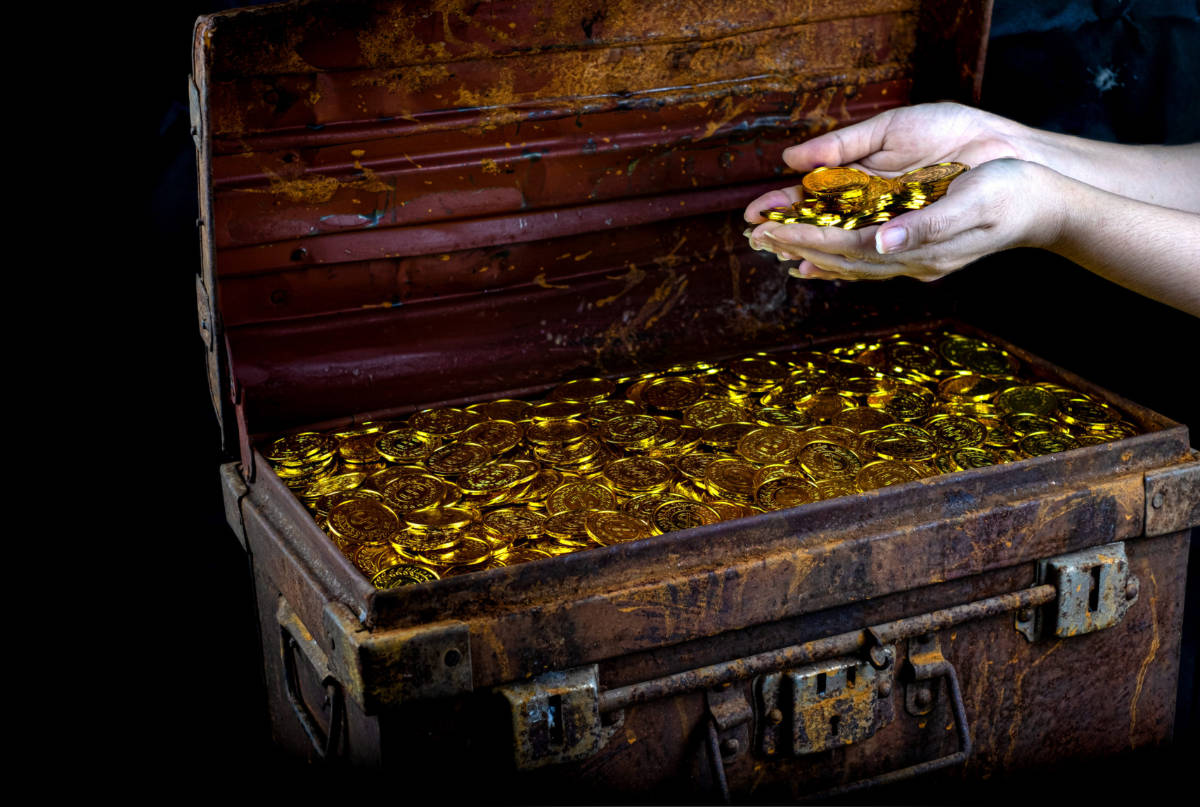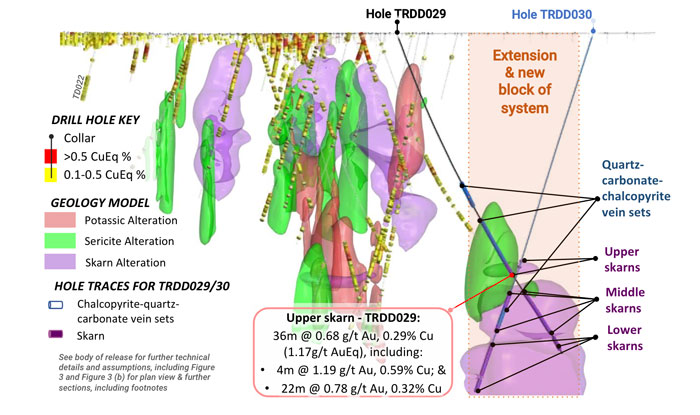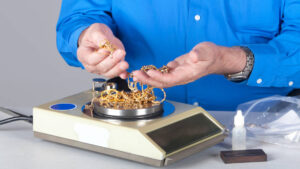Kincora is unveiling a treasure trove in the Lachlan Fold

Pic: Getty
Just two drill holes in and Kincora is already proving it is drilling into a significant new discovery at its Trundle project in NSW’s gold and copper rich Lachlan Fold Belt, with a new higher-grade zone confirmed and expanded. The last two holes have returned the most amounts of visual chalcopyrite to date at the project with a second rig ramping up drilling this week.
Not only has the latest hole drilled (TRDD030) into Kincora Copper’s (ASX:KCC) advanced Trundle project confirmed this new southern extension discovery zone, but it has significantly expanded the mineralised zones beyond that seen in the first hole, confirmed a second important mineralising phase to the system and provided significant geological information to guide follow up drilling.
Kincora’s working geological model and interpretation certainly appears to be working.
The Trundle Park prospect now has gold and copper mineralisation extending over a 1.3km strike, providing a significant search space that remains open in all directions, with this newly discovered southern extension getting the company’s seasoned explorers, who have found multiple previous world-class discoveries, pretty upbeat.

“While only two holes in, TRDD030 confirms we are onto something of significance in this newly identified southern extension of the mineralised system at Trundle Park and provides increasing confidence of our geological interpretations,” technical committee chair John Holliday and VP of exploration Peter Leaman said.
“Our working model is that TRDD029 and TRDD030 sit in a down faulted and more mineralised section of the wider system. We are seeing broad zones of multiple chalcopyrite bearing mineralising events and phases, and the most amounts of visual chalcopyrite to date at the Trundle project.”
Chalcopyrite is a primary ore mineral of copper and occurs in most sulphide mineral deposits around the world and the latest hole is seeing significant amounts of chalcopyrite from two separate mineralising events, both the multiple intersected skarn zones and quartz-carbonate veins sets. The skarn zones alone include a cumulative total interval of 250m (more than the 213m seen in the prior hole).
“The intersected skarns zones and vein sets systems have provided important vectors for follow up drilling and are suggestive of very considerable primary source,” Holliday and Leaman noted.
What Kincora is seeing at Trundle so far is typical of other major porphyry systems in the Macquarie Arc, and globally, with pathways between skarns and porphyry deposits.
Skarn deposits are generally formed on the peripheral to, and mineralising fluids sourced from, porphyry systems. While skarns can support significant mining operations in their own right they are more often developed concurrently with the causative intrusion and porphyry deposit(s), which are generally a magnitude larger in tonnage than the skarn.
Interestingly, the quartz-carbonate-chalcopyrite veins sets also noted in this latest hole are also interpreted as being indicative of leakage from an expected porphyry source.
The Northparkes mine and Newcrest Mining’s (ASX:NCM) Cadia operation, which also sit in the Macquarie Arc in the Lachlan Fold, both host skarn and porphyry resources.
Before current owner Newcrest’s time, mining occurred in 1850 and 1945 at the Cadia and Little Cadia skarns, which were the largest skarns in Australia. And CMOC and Sumitomo, the owners of Northparkes are currently permitting the E44 gold-copper skarn deposit as a first potential satellite operation to the existing mill.
The real treasure might be at depth
When Kincora started exploring at Trundle in April 2020, previous explorers had identified a 700m mineralised area at the Trundle Park prospect with an average drill depth of less than 30m.
Kincora recognised that there had been a lack of deeper drilling and drilling that would have intersected the core of the porphyry systems at either Cadia or Northparkes. This is despite Trundle sitting in the same mineralised system at Northparkes – which is Australia’s second largest porphyry mine with 22 discoveries to date, nine with proven positive economics.
A key change in exploration strategy to reflect this was developing a detailed 3D geological and geophysical model to assist advance and refine interpretations, identify mineralised trends and rank/test targets. This has resulted in a significantly improved geological understanding that has both guided and justified deeper drilling.
What has got Kincora excited about the southern trend extension, and holes TRDD029/30, is identifying multiple chalcopyrite bearing events and phases with the highest visual chalcopyrite seen to date at the Trundle project.
The size of the skarns (very significant in the context of the Macquarie Arc) and vein set systems are suggestive of a significant primary source, and interpreted porphyry deposit, which is the gold medal prize and target.
To date, assay results are only available for the Upper skarn, which returned 36m at 1.17 grams per tonne (g/t) gold equivalent. Remaining results are due in about two weeks and results of the latest hole (TRDD030) are expected in six weeks.
To put this first assay result into some perspective, the last reported quarter’s production from Cadia (Cadia East) included a mined head grade of 1.41g/t gold equivalent with an all-in sustaining cost margin of $1,519/oz.
This illustrates the favourable economic potential of bulk mining operations in the Lachlan Fold Belt at not dissimilar depths to these new mineralised zones identified at Trundle Park, with Kincora interpreting it is yet to hit the main part of the system.
Both the skarn and vein sets are providing Kincora directional guides (sometimes referred to as “vectors” by geologists) for where to drill next.
Initial follow up hole TRDD031 has commenced targeting the interpreted nearer surface part of the system. TRDD031 will test recently gained skarn bedding, chalcopyrite quartz vein orientation and the core of a magnetic high anomaly.
Other news today from Kincora is that a second rig has begun aircore drilling to test the wider intrusive complex and extent of identified anomalous copper-gold mineralisation at open pit target depths to the north of Trundle Park.
This follows Kincora intersecting nearer surface intrusions in holes TRDD028 and TRDD029 at the Trundle Park prospect.
Kincora plans to drill 2,020m across 54 holes, with the program expected to be completed within a month.
This article was developed in collaboration with Kincora Copper, a Stockhead advertiser at the time of publishing.
This article does not constitute financial product advice. You should consider obtaining independent advice before making any financial decisions.
Related Topics

UNLOCK INSIGHTS
Discover the untold stories of emerging ASX stocks.
Daily news and expert analysis, it's free to subscribe.
By proceeding, you confirm you understand that we handle personal information in accordance with our Privacy Policy.








